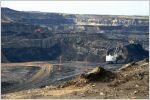
The Shell Albian oilsands mine in NE Alberta. Photo by Julia Kilpatrick
As children, we’re taught that if you make a mess you have to clean it up. This important lesson is applicable at every age, for messes big and small, and for individuals, governments and industry. This thinking is at the center of the “polluter pays” principle underpinning regulatory systems across the country, which holds that industry and its investors are accountable for the environmental consequences of their activities.
In practice however, regulators of Alberta’s oil and gas sector have not enforced this principle. Indeed, the Redwater case recently heard by the Supreme Court of Canada has exposed a massive liability iceberg in the province’s conventional oil and gas sector with no ideal outcome in sight. Due to decades of prioritizing industry interests over responsible regulatory management, the sector has accrued decades of backlogged cleanup obligations that amount to billions of dollars in liability.
The sizable liability arising from the older conventional oil and gas sector today raises serious questions about what tomorrow may hold for Alberta’s oilsands industry, which will likely result in even larger overall cleanup costs.
Redwater impacts will reverberate beyond conventional oil and gas
Although commentary on the Redwater case has largely focused on Alberta’s conventional oil and gas sector, it has significant implications for all of Canada’s extractive industries, ranging from hard rock mining, to hydraulic fracturing, to pulp and paper manufacturing. Canadians should understand the Supreme Court’s decision could set a precedent where all provincial regulators will be less able to protect the environment and public safety by holding extractive industries and their creditors accountable for their liabilities. This precedent has particularly concerning implications for oilsands mining.
In Canada, there are many examples of bankrupt mining companies leaving behind large messes for the public to deal with. Canadian taxpayers are currently footing billions for cleanup and perpetual management at former mining sites such as the Britannia, Brynnor, Bralorne-Takla and Atlin Ruffner Mines in British Columbia, the Giant Mine in the Northwest Territories, and the Faro Mine in the Yukon Territories. Based on this troubling history of bankruptcy and public financing to manage liabilities left on the landscape by companies, Albertans and Canadians should ask if we have sufficient processes and regulations in place to prevent a similar outcome in the oilsands sector.
Oilsands mining poised to follow in the conventional sector’s footsteps
Mining projects constitute roughly 50 per cent of all oilsands production in Alberta today, with the other half comprised of in-situ projects. Despite the enormity of liabilities incurred by these mines, the regulator has permitted companies to continuously kick the can down the road on cleanup obligations. Of course, this is precisely the approach that has created the fiscal and environmental crisis we are all watching unfold today in the conventional oil and gas sector.
According to the Alberta Energy Regulator (AER), less than three per cent of the conservatively estimated $27 billion needed to reclaim existing oilsands mining sites is currently held in securities by the province. This state of affairs is extremely concerning, as the sheer size and scope of the sector’s tailings ponds alone are globally unprecedented. Over the last 50 years industry has not found a commercially viable, timely, and effective cleanup method for these ponds, and as a result they have simply continued to grow on the landscape.
Rather than proactively addressing the tailings problem with clear and stringent regulations, the Alberta government has afforded an inordinate amount of latitude to the sector. Regulating the growth of tailings ponds wasn't even attempted until 2009 with Directive 074, which was a spectacular failure in terms of compliance and enforcement. And, rather than finally delivering real solutions, 2016’s Directive 085 simply serves the status quo by allowing tailings ponds to continue growing for decades with possible clean up coming from unproven and risky treatment and reclamation methods.
As oilsands mining is relatively carbon intensive compared to most other forms of oil extraction, the public should be very concerned about what might happen with these ever-growing ponds if the going gets tough for the sector in a rapidly decarbonizing world. If the AER and government continue to let industry follow the laissez-faire pathway of Alberta's conventional oil and gas industry, the public could be left to perpetually manage ecological messes with price tags many times greater than the cleanup costs of the infamous billion-dollar Faro and Giant Mines.
There are already countless signals this risk isn’t an unrealistic worry. International energy companies such as Shell, Statoil (now Equinor) and ConocoPhillips have sold most or all of their oilsands assets in recent years, recognizing that the long-term profitability of these high cost and high carbon projects are questionable in a global context where peak oil demand could occur between 2025 and 2040, and less carbon intensive sources of fossil fuels gain a larger share of the world’s decelerating needs.
Time to get our house in order
The Redwater case has propelled a national public policy debate about the underlying principles of Canada’s resource industries and whether our laws reflect Canadian values. It’s clear that regardless of the outcome, provincial and federal governments have a responsibility to re-examine priorities for our country’s industrial development.
If we value the public interest and wish to ensure polluters pay for their adverse social and environmental impacts, serious federal and provincial legislative changes are needed to protect the responsible segments of industry, landowners, and the public at large from shouldering the environmental and financial burden of the most irresponsible forms of development.
Check out our previous blogs: “A liability iceberg in Alberta exposed by the Redwater case,” discusses how the case has exposed a liability bubble in Alberta's conventional oil and gas sector. In “The catch-22 of the Redwater case,” we discuss how the system has historically failed to manage oil and gas liabilities in Alberta and how we can chart solutions moving forward.
Jodi McNeill was an analyst with the Pembina Institute, with a focus on fossil fuels in Alberta.
Nikki was a senior analyst for the Pembina Institute until 2020 with expertise on fossil fuel development.




